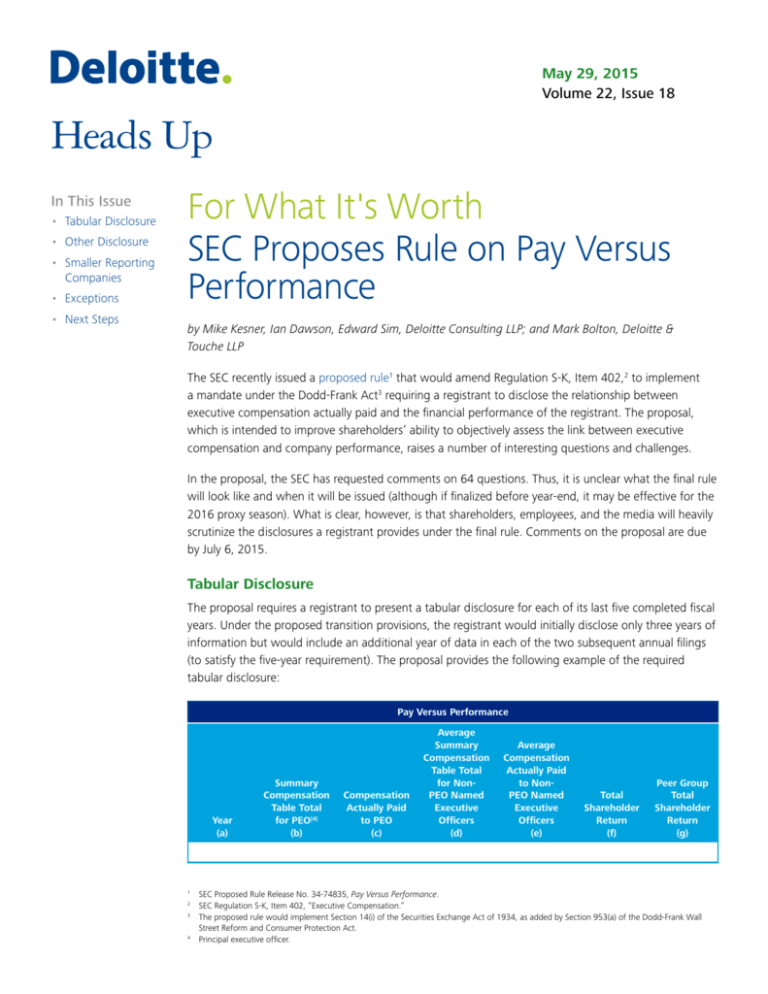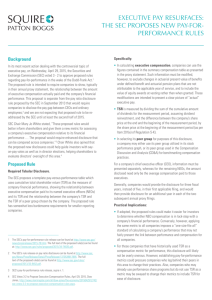
May 29, 2015
Volume 22, Issue 18
Heads Up
In This Issue
• Tabular Disclosure
• Other Disclosure
• Smaller Reporting
Companies
• Exceptions
• Next Steps
For What It's Worth
SEC Proposes Rule on Pay Versus
Performance
by Mike Kesner, Ian Dawson, Edward Sim, Deloitte Consulting LLP; and Mark Bolton, Deloitte &
Touche LLP
The SEC recently issued a proposed rule1 that would amend Regulation S-K, Item 402,2 to implement
a mandate under the Dodd-Frank Act3 requiring a registrant to disclose the relationship between
executive compensation actually paid and the financial performance of the registrant. The proposal,
which is intended to improve shareholders’ ability to objectively assess the link between executive
compensation and company performance, raises a number of interesting questions and challenges.
In the proposal, the SEC has requested comments on 64 questions. Thus, it is unclear what the final rule
will look like and when it will be issued (although if finalized before year-end, it may be effective for the
2016 proxy season). What is clear, however, is that shareholders, employees, and the media will heavily
scrutinize the disclosures a registrant provides under the final rule. Comments on the proposal are due
by July 6, 2015.
Tabular Disclosure
The proposal requires a registrant to present a tabular disclosure for each of its last five completed fiscal
years. Under the proposed transition provisions, the registrant would initially disclose only three years of
information but would include an additional year of data in each of the two subsequent annual filings
(to satisfy the five-year requirement). The proposal provides the following example of the required
tabular disclosure:
Pay Versus Performance
Year
(a)
Summary
Compensation
Table Total
for PEO[4]
(b)
Compensation
Actually Paid
to PEO
(c)
Average
Summary
Compensation
Table Total
for NonPEO Named
Executive
Officers
(d)
Average
Compensation
Actually Paid
to NonPEO Named
Executive
Officers
(e)
Total
Shareholder
Return
(f)
Peer Group
Total
Shareholder
Return
(g)
SEC Proposed Rule Release No. 34-74835, Pay Versus Performance.
SEC Regulation S-K, Item 402, “Executive Compensation.”
3
The proposed rule would implement Section 14(i) of the Securities Exchange Act of 1934, as added by Section 953(a) of the Dodd-Frank Wall
Street Reform and Consumer Protection Act.
4
Principal executive officer.
1
2
Editor’s Note: Many companies may find it challenging to determine (1) where to present
this disclosure and (2) how to integrate it into the other extensive compensation disclosures
already required by SEC rules. The proposal acknowledges that placement of the disclosure in
the compensation discussion and analysis (CD&A) section of a filing would suggest that the
relationship of pay to total shareholder return was a factor in establishing compensation, which
may not be the case. Therefore, under the proposed rule, companies retain the flexibility to place
the required disclosure wherever they believe it is most appropriate in the proxy. In addition,
companies may continue to compute and present other performance measures, such as realizable
compensation (as defined), that will allow them to “tell their own story” elsewhere in the CD&A.
Specific aspects of the tabular disclosure are discussed below.
Executive Officers
The executive officers under the proposed disclosures are the named executive officers (NEOs) as
specified in Item 402.5 Individual compensation amounts would be disclosed only for the PEO; average
compensation would be disclosed for the remaining NEOs.6
Editor’s Note: Although the SEC believes that averaging the compensation of non-PEO NEOs
would alleviate concerns about year-over-year and cross-company comparisons, changes in
the NEOs reported in the proxy each year could have a significant effect on annual changes
to average compensation for the non-PEOs. Similarly, the inclusion of more than one PEO’s
compensation during a transition year in the tabular disclosure could distort the compensation
value for that year and impair a financial statement user’s ability to draw meaningful conclusions
from the analysis.
Even in cases of PEO and NEO stability over a number of years, the value of compensation
actually paid lacks any context without peer or industry pay comparisons. For example, the
disclosure of a strong correlation between pay and performance does not provide shareholders
with a way to evaluate whether the level of pay is reasonable relative to the compensation
practices of the registrant’s peer group.
Summary Compensation Table Totals
Totals from the summary compensation table (SCT) would be obtained from the disclosure a registrant
must provide under Item 402(c).
Compensation Actually Paid
The Dodd-Frank mandate differs from other aspects of the Item 402 disclosure requirements by
focusing on compensation actually paid. To derive this amount (an individual amount for the PEO, and
the collective average for the other NEOs), a registrant would need to make certain adjustments to the
Regulation S-K, Item 402(a)(3) (Item 402(m)(2) for smaller reporting companies).
If more than one person served as the PEO during a particular fiscal year, the compensation of all PEOs would be aggregated in the disclosure.
5
6
2
compensation totals reported in the SCT and disclose the nature of those adjustments in footnotes to
the new tabular disclosure. For example, adjustments would need to be made to:
• Pension amounts — A registrant would first deduct from the SCT totals the aggregate change
in the actuarial present value of the accumulated benefit under all defined benefit and actuarial
pension plans reported in the SCT.7 It would then add back the service cost for those officers
under all of those pension plans attributable to services rendered during the specified fiscal
year. By making these adjustments, the registrant would essentially exclude all changes in
the pension amounts that are not attributable to the applicable year of service. Notably, this
adjustment would also eliminate significant changes in the present value of the pension as a
result of the change in interest rates.
• Equity awards — The proposal notes that equity awards would “be considered actually paid
on the date of vesting [and should be] valued at fair value on [the date of vesting] rather than
fair value on the date of grant as required in the [SCT].” Fair values would be determined in
accordance with the FASB’s guidance on equity award valuation (i.e., ASC 7188). Accordingly, a
registrant would (1) deduct from the SCT total compensation amounts for awards of stock and
options that are computed at aggregate grant-date fair value and (2) add back the vestingdate fair value of all stock and option awards that vested during the covered fiscal year. The
proposal also requires a registrant to describe any valuation assumptions that are materially
different from those used to compute the compensation amount included in the SCT in a
footnote to the pay-versus-performance table.
Editor’s Note: The computation of compensation actually paid would be as follows:
SCT total compensation
Less: Change in pension value disclosed in the SCT
Less: Grant-date fair value of stock and option awards disclosed in the SCT
Plus: Service cost under all defined benefit plans for services rendered during the year
Plus: Vesting-date fair value of equity awards that vested during the applicable year
The “add-back” adjustments related to pension and equity awards are not required disclosures
under the current compensation disclosure rules. As the proposal states, the SEC believes that
the “valuation of options as of a different date and the required computations with respect to
pension plans can be accomplished by entering new inputs into the existing valuation models
used to calculate currently disclosed values.”
Use of the Black-Scholes model (or other option pricing models) to value stock options as they
vest does not take into account the amount an executive could actually realize at the time of
vesting (e.g., options could be underwater but a positive amount for paid compensation could
still be reported under Black-Scholes). Therefore, it is possible that the proposed valuation method
could lead to a decrease in the use of stock options unless the SEC ultimately decides to require
use of a different valuation method, such as intrinsic value at the vesting date (i.e., the difference
between the fair value of an option on the date of vesting and the option exercise price).
Total Shareholder Return
The method for determining total shareholder return (TSR) under the proposal is the same as that used
in Regulation S-K, Item 201(e).9 That is, a registrant would divide “the (i) sum of (A) the cumulative
amount of dividends for the measurement period, assuming dividend reinvestment, and (B) the
difference between the registrant's share price at the end and the beginning of the measurement
period; by (ii) the share price at the beginning of the measurement period.”
Such amount is only deducted if it is a positive amount.
FASB Accounting Standards Codification Topic 718, Compensation — Stock Compensation.
9
SEC Regulation S-K, Item 201, “Market Price of and Dividends on the Registrant's Common Equity and Related Stockholder Matters.”
7
8
3
Under the proposal, a registrant uses the same method to compute the cumulative TSR for both itself
and its peer group for each fiscal year included in the table. For peer group computations, a registrant
uses the index or issuers it uses for either the performance graph disclosure required by Item 201(e) or
the group used for compensation benchmarking practices in the CD&A.10 The TSR of each peer in the
group would be weighted by each peer’s respective stock market capitalization at the beginning of the
measurement period.
Cumulative TSR for each fiscal year would be measured as a change from an initial, fixed investment.
No averaging of stock prices is permitted. TSR would be based on the closing stock price on the last day
of the applicable fiscal year.
Editor’s Note: TSR is perhaps the most objective and transparent performance metric available
for measuring long-term financial performance. Assessing TSR over a five-year period gives a
clear illustration of long-term performance. Further, unlike the disclosures of compensation
actually paid, which do not include peer comparisons, the TSR disclosure enables a registrant to
select a suitable peer group for comparison purposes, giving both flexibility to the registrant and
important context for evaluating a registrant’s relative performance to the financial statement
user. Because TSR is weighted by market capitalization, companies will need to be careful about
using the compensation peer group for TSR purposes because one or two companies with high
market capitalizations could distort the peer group’s TSR.
Other Disclosure
In addition to providing the tabular disclosure, a registrant would be required under the proposal to
clearly describe the relationship between the following:
• The executive compensation actually paid to the NEOs and the registrant’s TSR.
• The registrant’s TSR and the peer group’s TSR.
Editor’s Note: Attempting to explain the relationship between paid compensation and TSR
(or lack thereof) will be quite challenging because most compensation decisions do not revolve
around TSR. Further, the lack of alignment between the TSR measurement period (fiscal year) and
the vesting period of the majority of long-term incentive plans (under whose terms, in most cases,
awards vest in February/March for calendar-year companies) may magnify this challenge and
encourage boards to shift vesting schedules closer to year-end to increase the overlap between
the timing of the performance period and award valuation.
The proposal indicates that this description should follow the tabular disclosure; however, it does not
specify the format of the description and states that it could be narrative, graphic, or a combination
of both. For example, it could consist of “a graph providing executive compensation actually paid and
change in TSR on parallel axes and plotting compensation and TSR over the required time period.”
Alternatively, a registrant could describe the relationship by “showing the percentage change over each
year of the required time period in both executive compensation actually paid and TSR together with a
brief discussion of that relationship.”
10
If a registrant’s peer group is not a published industry or line-of-business index, the registrant must identify the issuers in the peer group.
4
The proposal also requires registrants to electronically tag the disclosure by using XBRL11 and to include
the interactive data files “as an exhibit to definitive Schedule 14A . . . or definitive Schedule 14C” (as
applicable). Specifically:
• Each amount included in the tabular disclosure would be tagged separately.
• Block-text tags would be applied to:
o
o
Footnotes to the tabular disclosure describing (1) the adjustments made to compute the
executive compensation paid and (2) any material differences in the valuation assumptions
used for equity awards.
The description of the relationship between (1) executive compensation actually paid and
the registrant’s TSR and (2) the registrant’s TSR and the peer group’s TSR.
Smaller Reporting Companies
The proposal provides certain relief to smaller reporting companies.12 Such companies would:
• Need to provide only three years of information instead of five years.
• Not need adjust executive compensation actually paid for amounts related to pensions.
• Not need to disclose the TSR of their peer group.
• Upon initial adoption, need to provide information for only two years of data instead of three
(and three years in all subsequent filings).
• Not be required to provide interactive data in an XBRL format until their third filing that
includes the pay-versus-performance disclosure.
Exceptions
Foreign private issuers, emerging growth companies, and registered investment companies would be
exempt from the requirements.
Next Steps
Because of the potential sensitivity associated with any disclosures about executive compensation,
registrants affected by the proposal should review their past compensation practices and assess
whether the proposed requirements would appropriately convey to investors the relationship between
their executive compensation practices and company performance. One way of doing so might be to
model the proposed disclosures by using data for the past several years. Modeling might reveal possible
unintended consequences of the proposal or the need to develop a strategy for communicating to
investors the effects of specific aspects of the disclosures. Because the proposal requests comment on
virtually all aspects of its provisions, registrants will have the opportunity to express their concerns and
recommend improvements or disclosure alternatives.
11
12
eXtensible Business Reporting Language.
SEC Regulation S-K, Item 10(f)(1), "Smaller Reporting Companies," defines smaller reporting companies.
5
Subscriptions
If you wish to receive Heads Up and other accounting publications issued by Deloitte’s Accounting Standards and Communications
Group, please register at www.deloitte.com/us/subscriptions.
Dbriefs for Financial Executives
We invite you to participate in Dbriefs, Deloitte’s webcast series that delivers practical strategies you need to stay on top of
important issues. Gain access to valuable ideas and critical information from webcasts in the “Financial Executives“ series on the
following topics:
• Business strategy and tax.
• Financial reporting for taxes.
• Driving enterprise value.
• Governance, risk, and compliance.
• Financial reporting.
• Technology.
• Transactions and business events.
Dbriefs also provides a convenient and flexible way to earn CPE credit — right at your desk. Subscribe to Dbriefs to receive
notifications about future webcasts at www.deloitte.com/us/dbriefs.
Technical Library and US GAAP Plus
Deloitte makes available, on a subscription basis, access to its online library of accounting and financial disclosure literature. Called
Technical Library: The Deloitte Accounting Research Tool, the library includes material from the FASB, EITF, AICPA, PCAOB, IASB,
and SEC, in addition to Deloitte’s own accounting and SEC manuals and other interpretive accounting and SEC guidance.
Updated every business day, Technical Library has an intuitive design and navigation system that, together with its powerful
search features, enable users to quickly locate information anytime, from any computer. Technical Library subscribers also receive
Technically Speaking, the weekly publication that highlights recent additions to the library. For more information, including
subscription details and an online demonstration, visit www.deloitte.com/us/techlibrary.
In addition, be sure to visit US GAAP Plus, our free Web site that features accounting news, information, and publications with a
U.S. GAAP focus. It contains articles on FASB activities and updates to the FASB Accounting Standards Codification™ as well as
developments of other U.S. and international standard setters and regulators, such as the PCAOB, AICPA, SEC, IASB, and
IFRS Interpretations Committee. Check it out today!
Heads Up is prepared by the National Office Accounting Standards and Communications Group of Deloitte as
developments warrant. This publication contains general information only and Deloitte is not, by means of this
publication, rendering accounting, business, financial, investment, legal, tax, or other professional advice or
services. This publication is not a substitute for such professional advice or services, nor should it be used as a
basis for any decision or action that may affect your business. Before making any decision or taking any action
that may affect your business, you should consult a qualified professional advisor.
Deloitte shall not be responsible for any loss sustained by any person who relies on this publication.
As used in this document, “Deloitte“ means Deloitte & Touche LLP, a subsidiary of Deloitte LLP. Please see
www.deloitte.com/us/about for a detailed description of the legal structure of Deloitte LLP and its subsidiaries.
Certain services may not be available to attest clients under the rules and regulations of public accounting.
Copyright © 2015 Deloitte Development LLC. All rights reserved.
Member of Deloitte Touche Tohmatsu Limited.
6






